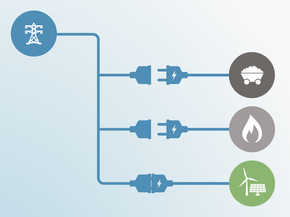Net zero targets
Summary
We evaluate the net zero target as: Average.
The Biden Administration submitted the US long-term strategy to the UNFCCC in November 2021 (U.S. Department of State, 2021b), officially committing the US to net zero emissions by 2050 at the latest. The net zero target covers all greenhouse gas (GHG) emissions, makes transparent assumptions on CO2 removal by land-based and technology-based solutions, and specifies several key components for comprehensive planning.
The US government has several avenues to improve the scope, target architecture and transparency of its net zero target. The US government could include international aviation and shipping to its target coverage, and explicitly commit to reach net zero emissions within its own borders without any use of international offsets. Furthermore, the target itself could be enshrined in law in combination with adopting a legally-binding review, revision, and reporting mechanism. The US government further ought to explain why its net zero target is a fair contribution to the global goal of limiting warming to 1.5˚C above pre-industrial levels, and transparently address any existing gap between its net zero target and what would be a fair target.
CAT analysis of net zero target
Ten key elements
Scope
- Target year – The US government commits to reach net zero emissions by 2050 latest (U.S. Department of State, 2021b).
- Emissions coverage – The US net zero target includes all greenhouse gas (GHG) emissions (U.S. Department of State, 2021b).
- International aviation and shipping – The US government deliberately excludes international aviation and shipping from its net zero target’s coverage (U.S. Department of State, 2021b).
- Reductions or removals outside of own borders – The US government reserves its rights to use international market mechanisms toward achievement of this net-zero goal (U.S. Department of State, 2021b), even if it currently does not expect to do so.
Target architecture
- Legal status – The US government submitted its updated long-term strategy (LTS) including its net zero announcement to the UNFCCC in November 2021 (U.S. Department of State, 2021b). The net zero target has not yet been enshrined in law as of November 2021.
- Separate reduction & removal targets – The US government does not provide separate emission reduction and removal targets.
- Review process – The LTS specifies that progress toward the net zero target will be regularly assessed without providing further specific information on the envisioned processes. The US government further announces its intention to maybe update US LTS in the future but does not commit to any legally-binding revisions process.
Transparency
- Carbon dioxide removal – The US government provides transparent assumptions and pathways on both natural sinks and technology-based CDR towards 2050 (U.S. Department of State, 2021b). Land‑based sinks reach roughly minus 600–1,400 MtCO2e in 2050, while technology-based CDR reach roughly minus 300–500 MtCO2e in 2050. On the latter, no detailed information is provided on storage capacities for captured carbon emissions nor the combination of technologies envisioned to increase this sink, due to uncertainties and current early stage of development.
- Comprehensive planning – The updated LTS presents multiple pathways and a set of transparent assumptions to reach net zero emissions by 2050 latest (U.S. Department of State, 2021b). The government outlines multiple measures and actions across different sectors, most prominently to fully decarbonising domestic electricity supply by 2035 (assuming a substantial increase of electricity generation capacity using fossil fuels equipped with CCS in 2050). Other intermediate target in the transport sector, for example, are to (1) increase the share of new zero-emissions light-duty cars sold in 2030 to 50% of total sales and to (2) produce 3 billion gallons of sustainable aviation fuel by 2030. As of October 2021, the US Congress has not passed legislation for funding. The US government further announced to publish a ‘The U.S. National Climate Strategy (NCS)’ alongside its LTS. The US government claims that the NDC target is fully aligned with pathways reaching net zero target.
- Clarity on fairness of target – The US government makes no reference to fairness or equity in the context of its net zero target.
Good practice
The Climate Action Tracker has defined the following good practice for all ten key elements of net zero targets. Countries can refer to this good practice to design or enhance their net zero targets.
Further analysis
Latest publications
Stay informed
Subscribe to our newsletter







